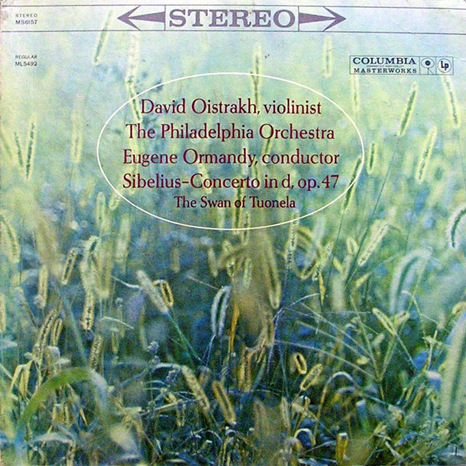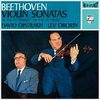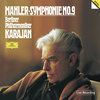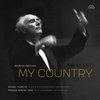AAA 100% Analogue This Speakers Corner LP was Remastered using Pure Analogue Components Only, from the Master Tapes through to the Cutting Head
Speakers Corner / Columbia Masterworks - MS6157 - 180 Gram Virgin Vinyl
AAA 100% Analogue - Mastered by Kevin Gray at Cohearant Audio
Limited Edition - Pressed at Pallas Germany
Speakers Corner 25 Years Pure Analogue This LP is an Entirely Analogue Production
The jewel in the Speakers Corner Columbia crown ,The Columbia classical reissues from Speakers Corner have uniformly been excellent, but this reissue is extraordinary. The performances are of course top notch, but what stands out even more with this reissue is the sound quality. This is amongst the very best classical recordings I have ever heard, regardless of label, with soundstaging, focus, clarity and air in abundance. The sound of the first violin section, for example, often relatively rough and uncouth sounding in this repertoire, is detailed and clear with extended frequency response, but also smooth sounding. The presence of quite noticeable tape hiss suggests that we are listening to a record made with no "intervention" or "improvement" at any time right from the original recording session through to the pressing of this reissue 55 years later. It certainly puts to complete and utter shame previous efforts over the last few decades to put this recording onto CD. LP Review
Jean Sibelius: Concerto for Violin and Orchestra in D Minor Op. 47, "The Swan of Tuonela" from the "Lemminkäinen Suite" Op. 22 - David Oistrakh and the Philiadelphia Orchestra, conducted by Eugene Ormandy
Not always do composers of instrumental works take the playability of their ideas into consideration. Jean Sibelius – himself an excellent violinist – must have been aware of the enormous challenges to the soloist, but he did not, however, envisage that the première of his violin concerto would be badly received due to the inadequacy of the violinist. That his op. 47 would become a showpiece of romantic violin repertoire is certainly not only due to the first-class soloists of our time, but also thanks to the work’s broad and expressive melodies. In the short introduction of the second movement, the leaping intervals of the violin – as though from nowhere – develop into a broad symphonic dialogue with a late-romantic inflection, which is unleashed to create an emotional climax in the 20-bar main theme of the second movement. Seemingly purposely written for the nimble fingers of the world-class violinist, David Oistrakh and the evenly matched Philadelphia Orchestra present a superbly virtuosic and powerful rendering right up to the rousing finale. As an encore we hear "The Swan Of Tuonela" sing its tender, sublime song in a substantial solo on the cor anglais.
Composers of instrumentalists do not always give ruthless attention to the playability of their ideas. However, Jean Sibelius, himself an excellent violinist, might have known the tremendous challenges of the soloists, but he could not foresee that the first performance of his violin concerto was not very enthusiastic because of his inadequacies. The fact that Opus 47 nevertheless rose to the paradigm of romantic violin literature, is due not only to the first-class soloists of our time, but to his wide-bodied, expressive melody. As out of nothing of the short prelude, the violin's violin intervals evolve into the broad symphonic dialogue in late-romantic tone, which unleashes itself in the 20-measure main theme of the second movement of the emotional summit. As described for the nimble fingers of the violinist by world class, David Oistrakh and a Philadelphia Philharmonic present the virtuoso and powerful performance up to the sweeping finale. As an encore, "The Swan of Tuonela", Op. 22 his delicate and sublime song in the form of the widely performed solos of the English horn.
This Speakers Corner production was produced using analogue masterband and mastering 100% pure analogue. All licenses and GEMA contributions were paid. 22 his delicate and sublime song in the form of the widely performed solos of the English horn. This Speakers Corner production was produced using analogue masterband and mastering 100% pure analogue.
All licenses and GEMA contributions were paid. 22 his delicate and sublime song in the form of the widely performed solos of the English horn. This Speakers Corner production was produced using analogue masterband and mastering 100% pure analogue. All licenses and GEMA contributions were paid.
Recording: December 1959 and January 1960 at Broadwood Hotel, Philadelphia (USA)
Production: Howard Scott
Musicians:
David Oistrakh, violin
Philadelphia Orchestra
Eugene Ormandy, conductor
Selections:
Jean Sibelius (1865 - 1957)
Concerto in D minor, Op. 47
1. Allegro Moderato
2. Adagio Di Molto
Side B:
1. III Allegro, Ma Non Tanto
From Lemminkainen Suite Op. 22:
2. The Swan of Tuonela
Recording: December 1959 and January 1960 at Broadwood Hotel, Philadelphia (PA)
Production: Howard Scott
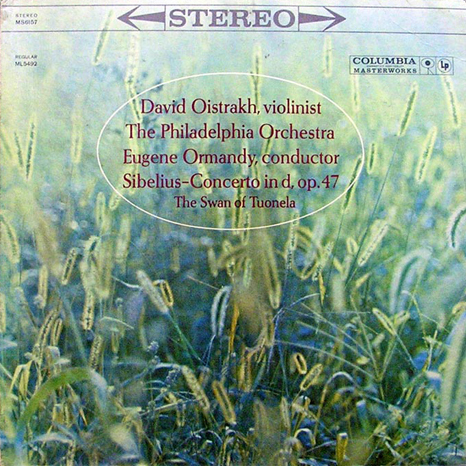
20 Years pure Analogue
Are your records completely analogue?
Yes! This we guarantee!
As a matter of principle, only analogue masters are used, and the necessary cutting delay is also analogue. All our cutting engineers use only Neumann cutting consoles, and these too are analogue. The only exception is where a recording has been made – either partly or entirely – using digital technology, but we do not have such items in our catalogue at the present time
Are your records cut from the original masters?
In our re-releases it is our aim to faithfully reproduce the original intentions of the musicians and recording engineers which, however, could not be realised at the time due to technical limitations. Faithfulness to the original is our top priority, not the interpretation of the original: there is no such thing as a “Speakers Corner Sound”. Naturally, the best results are obtained when the original master is used. Therefore we always try to locate these and use them for cutting. Should this not be possible, – because the original tape is defective or has disappeared, for example – we do accept a first-generation copy. But this remains an absolute exception for us.
Who cuts the records?
In order to obtain the most faithful reproduction of the original, we have the lacquers cut on the spot, by engineers who, on the whole, have been dealing with such tapes for many years. Some are even cut by the very same engineer who cut the original lacquers of the first release. Over the years the following engineers have been and still are working for us: Tony Hawkins, Willem Makkee, Kevin Gray, Maarten de Boer, Scott Hull, and Ray Staff, to name but a few.
At the beginning of the ‘90s, in the early days of audiophile vinyl re-releases, the reissue policy was fairly straightforward. Companies such as DCC Compact Classics, Mobile Fidelity, Classic Records and others, including of course Speakers Corner, all maintained a mutual, unwritten code of ethics: we would manufacture records sourced only from analogue tapes.
Vinyl’s newfound popularity has led many other companies to jump on the bandwagon in the hope of securing a corner of the market. Very often they are not so ethical and use every imaginable source from which to master: CDs, LPs, digital files and even MP3s.
Even some who do use an analogue tape source employ a digital delay line, a misguided ’80s and ‘90s digital technology that replaces the analogue preview head originally used to “tell” the cutter head in advance what was about to happen musically, so it could adjust the groove “pitch” (the distance between the grooves) to make room for wide dynamic swings and large low frequency excursions. Over time analogue preview heads became more rare and thus expensive.
So while the low bit rate (less resolution than a 16 bit CD) digital delay line is less expensive and easier to use than an analogue “preview head”, its use, ironically, results in lacquers cut from the low bit rate digital signal instead of from the analogue source!
Speakers Corner wishes to make clear that it produces lacquers using only original master tapes and an entirely analogue cutting system. New metal stampers used to press records are produced from that lacquer. The only exceptions are when existing metal parts are superior to new ones that might be cut, which includes our release of “Elvis is Back”, which was cut by Stan Ricker or several titles from our Philips Classics series, where were cut in the 1990s using original master tapes by Willem Makkee at the Emil Berliner Studios. In those cases we used only the original “mother” to produce new stampers.
In addition, we admit to having one digital recording in our catalogue: Alan Parsons’ “Eye in the Sky”, which was recorded digitally but mixed to analogue tape that we used to cut lacquers.
In closing, we want to insure our loyal customers that, with but a few exceptions as noted, our releases are “AAA”— analogue tape, an all analogue cutting system, and newly cut lacquers.
PALLAS
Audiophile Vinyl - Made in Germany For over 60 years the family business in the third generation of the special personal service and quality "Made by Pallas" is known worldwide. Our custom PVC formulation produces consistently high pressing quality with the lowest surface noise in the industry. Our PVC complies with 2015 European environmental standards and does not contain toxic materials such as Lead, Cadmium or Toluene. Our vinyl is both audiophile and eco-grade!
